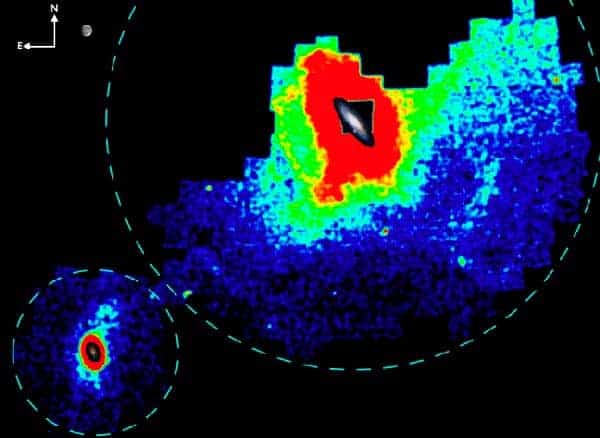
An international team of astrophysicists has mapped the borderlands between two of our neighbouring galaxies to reveal an ongoing galactic jostle that will eventually result in the formation of one super-galaxy incorporating the Milky Way. The findings provide the first qualitative evidence outside of the Milky Way that galaxies evolve through the merging of smaller galaxies.
Alan McConnachie of the NRC Herzberg Institute of Astrophysics, Canada, and his colleagues in the US, Europe and Australia set out to shed new light on the dynamics of galaxy evolution. They focused on two of our closest galactic neighbours to establish the extent and nature of any interaction that may be taking place. To do this, they combined computer simulations with new images captured by the Canada-France-Hawaii Telescope (CFHT) located near the summit of Mauna Kea in Hawaii.
First, the researchers surveyed Andromeda, which is the closest large galaxy to the Milky Way and contains a similar number of stars – around 100 billion. While the central disc of Andromeda is one of the most photographed objects in the sky, the outer sections are still relatively unobserved. McConnachie and his team have now vastly extended the survey and show that Andromeda has stars stretching over an area more than 100 times larger than the central disc. “The fact that we are looking so far out from the centre of the galaxy, and yet still detecting stars in this galaxy at these positions, really demonstrates just how large this galaxy is,” says McConnachie.
Ripping off a limb
Next, the researchers turned their attention to one of Andromeda’s smaller satellites, Triangulum – a densely-packed galaxy of about one-tenth the size of its spiral neighbour. What they observed was an extended, stream-like structure protruding from Triangulum in the direction of Andromeda. They conclude that this structure is very similar to what they would expect to see around a smaller galaxy that is interacting with a massive galaxy that is “ripping” stars from it.
Having made these observations, the researchers then looked to see if the laws of physics would permit such a violent interaction of this kind, given that we know these galaxies are moving in a certain way in relation to each other. Using computer simulations, they estimate that this stellar assault must have occurred roughly 2 billion years ago when Triangulum passed within 100,000 light years of Andromeda.
According to McConnachie, the encounter was aggressive but it was still a long way from being a head-on collision. The astrophysicist warns, however, that Triangulum may not come off so lightly when the two galaxies interact again, which is likely to occur within the next 2 billion years. “It’s unlikely Triangulum will be able to escape this time, and it’s very likely that the two galaxies will completely merge together soon afterwards.”
The fate of the Milky Way
By the time Triangulum is approaching Andromeda again, the Milky Way and Andromeda will have moved much closer together. McConnachie predicts that all three galaxies will probably collide together at the same time resulting in a merger and the formation of a new, larger galaxy. This process is a common occurrence in the “hierarchical” model of galaxy evolution.
Nickolay Gnedin, a member of the Theoretical Astrophysics Group at Fermilab in the US, believes that this new research is important because it extends our picture of galaxy evolution beyond our own galaxy. “The Milky Way is a wonderful galaxy and we learned a great deal about galaxies in general from it alone, but one can never be sure that the Milky Way is not special or unusual in some particular way, so a confirmation from a different galaxy is very important.”
Gnedin also believes that Andromeda and Triangulum will merge within a few billion years but he has a slightly different take on the fate of the Milky Way. “The merger between Triangulum and Androme will not gobble up the Milky Way, but the Milky Way and Andromeda will collide and merge together in about 3 billion years.”
This research is published in the latest edition of Nature.



